« October 2008 | HOME PAGE | December 2008 »
November 25, 2008
The Monkey King's House of Horrors

I've been meaning to post these video clips since I shot them last summer. This Journey to the West (西遊記/Xīyóujì) -themed House of Horrors is the centerpiece of a rather large, unattractive, and unattended amusement park/zoo right in the center of Korla.
It's called Peacock Park after the misnamed Peacock River (based on a misleading transliteration from Uyghur, but that's a long story). The bottom line: this place is a huge waste of space on prime riverside real estate. I don't expect it to last for very long.
This particular attraction was one of my favorite quirky finds in all of Xinjiang. Don't miss the awesome string-pulling and recorded loop technology in action!
One thing I can tell you is that no matter how ridiculous it looks from home, this place was more than a little bit freaky to wander through alone. (Alright, I was scared.) Hang around places like this too often and your life's apt to turn into an ugly scene from a B movie.
A few random photos after the break...
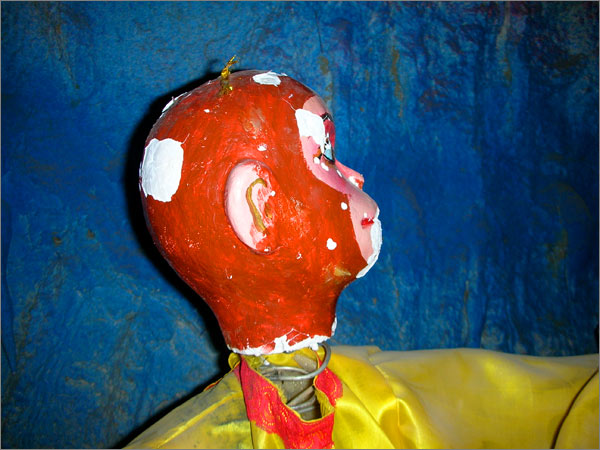

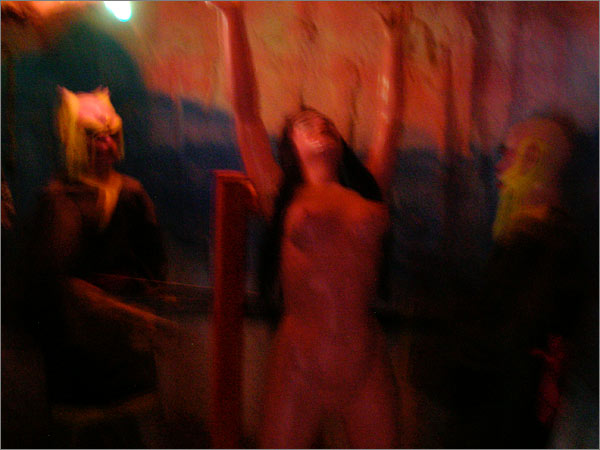
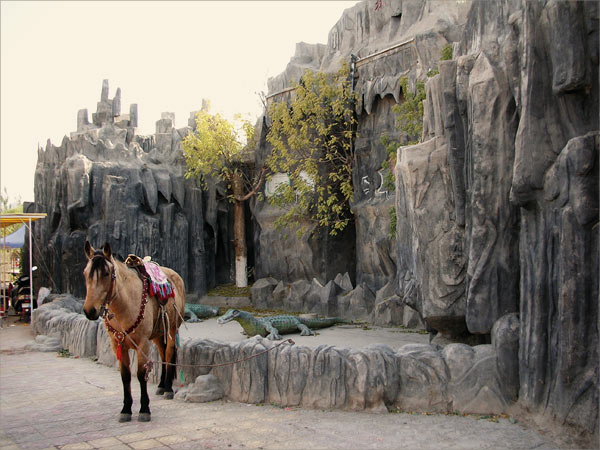
posted November 25, 2008 at 07:22 PM unofficial Xinjiang time | Comments (76)
November 21, 2008
LIFE in Xinjiang

Like many of you, I've been spending endless hours browsing through Google's newly debuted LIFE photo archive. There are some real Xinjiang gems in there, which I hope to feature here from time to time.
Click on the image above for the complete photo. Old school!
posted November 21, 2008 at 07:52 AM unofficial Xinjiang time | Comments (169)
November 20, 2008
Mysterious Mummies? Maybe 10 Years Ago.
What is news?
Just from the way it's spelled, there's fairly clearly a connection to new-ness, timeliness, etc. But if you've never heard the story — although it's been floating around for 10, 20... or even 100 years in some circles — does that automatically make it news?
That's the question I have about a current New York Times story that was briefly listed as the front page feature earlier today, titled "The Dead Tell a Tale China Doesn’t Care to Listen To":
URUMQI, China — An exhibit on the first floor of the museum here gives the government’s unambiguous take on the history of this border region: “Xinjiang has been an inalienable part of the territory of China,” says one prominent sign.
But walk upstairs to the second floor, and the ancient corpses on display seem to tell a different story.
One called the Loulan Beauty lies on her back with her shoulder-length hair matted down, her lips pursed in death, her high cheekbones and long nose the most obvious signs that she is not what one thinks of as Chinese.
The Loulan Beauty is one of more than 200 remarkably well-preserved mummies discovered in the western deserts here over the last few decades. The ancient bodies have become protagonists in a very contemporary political dispute over who should control the Xinjiang Uighur Autonomous Region.
Not that I don't get the "hook" to modern-day tensions in Xinjiang, but how is this news? Aurel Stein was picking up European-looking corpses wearing tartan socks a hundred years ago.
And I'm sure this 1998 documentary on the "Mysterious Mummies of China" from the program NOVA wasn't breaking any headlines at the time either:
That Chinese scientist's necrophilia is a bit creepy, no? And did you see the mummy's face?
In the 10 years since that TV program was made, the Loulan Beauty appears to either have a)turned black or b)been shellaced. Here's a comparison:
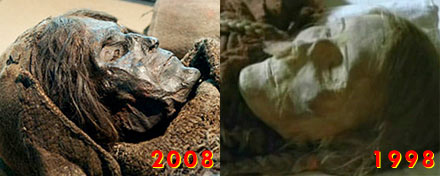
Now that's what I call news.
Also note that both the documentary and the Times article both use the same Western scientist, Prof. Victor H. Mair, as a primary source. I could do that! So how about a job, Jim Yardley?
P.S. Wait for the last 30 seconds of the video to hear the announcer call Xinjiang's most prominent ethnic group Wiggers. Priceless.
The Dead Tell a Tale China Doesn’t Care to Listen To
By EDWARD WONG
November 19, 2008
The New York Times
URUMQI, China — An exhibit on the first floor of the museum here gives the government’s unambiguous take on the history of this border region: “Xinjiang has been an inalienable part of the territory of China,” says one prominent sign.
But walk upstairs to the second floor, and the ancient corpses on display seem to tell a different story.
One called the Loulan Beauty lies on her back with her shoulder-length hair matted down, her lips pursed in death, her high cheekbones and long nose the most obvious signs that she is not what one thinks of as Chinese.
The Loulan Beauty is one of more than 200 remarkably well-preserved mummies discovered in the western deserts here over the last few decades. The ancient bodies have become protagonists in a very contemporary political dispute over who should control the Xinjiang Uighur Autonomous Region.
The Chinese authorities here face an intermittent separatist movement of nationalist Uighurs, a Turkic-speaking Muslim people who number nine million in Xinjiang.
At the heart of the matter lie these questions: Who first settled this inhospitable part of western China? And for how long has the oil-rich region been part of the Chinese empire?
Uighur nationalists have gleaned evidence from the mummies, whose corpses span thousands of years, to support historical claims to the region.
Foreign scholars say that at the very least, the Tarim mummies — named after the vast Tarim Basin where they were found — show that Xinjiang has always been a melting pot, a place where people from various corners of Eurasia founded societies and where cultures overlapped.
Contact between peoples was particularly frequent in the heyday of the Silk Road, when camel caravans transported goods that flowed from as far away as the Mediterranean. “It’s historically been a place where cultures have mixed together,” said Yidilisi Abuduresula, 58, a Uighur archaeologist in Xinjiang working on the mummies.
The Tarim mummies seem to indicate that the very first people to settle the area came from the west — down from the steppes of Central Asia and even farther afield — and not from the fertile plains and river valleys of the Chinese interior. The oldest, like the Loulan Beauty, date back 3,800 years.
Some Uighurs have latched on to the fact that the oldest mummies are most likely from the west as evidence that Xinjiang has belonged to the Uighurs throughout history. A modern, nationalistic pop song praising the Loulan Beauty has even become popular.
“The people found in Loulan were Uighur people, according to the materials,” said a Uighur tour guide in the city of Kashgar who spoke on condition of anonymity for fear of running afoul of the Chinese authorities. “The nationalities of Xinjiang are very complicated. There have been many since ancient times.”
Scholars generally agree that Uighurs did not migrate to what is now Xinjiang from Central Asia until the 10th century. But, uncomfortably for the Chinese authorities, evidence from the mummies also offers a far more nuanced history of settlement than the official Chinese version.
By that official account, Zhang Qian, a general of the Han dynasty, led a military expedition to Xinjiang in the second century B.C. His presence is often cited by the ethnic Han Chinese when making historical claims to the region.
The mummies show, though, that humans entered the region thousands of years earlier, and almost certainly from the west.
What is indisputable is that the Tarim mummies are among the greatest recent archaeological finds in China, perhaps the world.
Four are in glass display cases in the main museum here in Urumqi, the regional capital. Their skin is parched and blackened from the wear and tear of thousands of years, but their bodies are strikingly intact, preserved by the dry climate of the western desert.
Some foreign scholars say the Chinese government, eager to assert a narrative of longtime Chinese dominance of Xinjiang, is unwilling to face the fact that the mummies provide evidence of heterogeneity throughout the region’s history of human settlement.
As a result, they say, the government has been unwilling to give broad access to foreign scientists to conduct genetic tests on the mummies.
“In terms of advanced scientific research on the mummies, it’s just not happening,” said Victor H. Mair, a professor of Chinese language and literature at the University of Pennsylvania who has been at the forefront of foreign scholarship of the mummies.
Mr. Mair first spotted one of the mummies, a red-haired corpse called the Cherchen Man, in the back room of a museum in Urumqi while leading a tour of Americans there in 1988, the first year the mummies were put on display.
Since then, he says that he has been obsessed with pinpointing the origins of the mummies, intent on proving a theory dear to him: that the movement of peoples throughout history is far more common than previously thought.
Mr. Mair has assembled various groups of scholars to do research on the mummies. In 1993, the Chinese government tried to prevent Mr. Mair from leaving China with 52 tissue samples after having authorized him to go to Xinjiang and to collect them.
But a Chinese researcher managed to slip a half-dozen vials to Mr. Mair. From those samples, an Italian geneticist concluded in 1995 that at least two of the mummies had a European genetic marker.
The Chinese government in recent years has allowed genetic research on the mummies to be conducted only by Chinese scientists.
Jin Li, a well-known geneticist at Fudan University in Shanghai, tested the mummies in conjunction with a 2007 National Geographic documentary. He concluded that some of the oldest mummies had East Asian and even South Asian markers, though the documentary said further testing needed to be done.
Mr. Mair has disputed any suggestion that the mummies were from East Asia. He believes that East Asian migrants did not appear in the Tarim Basin until much later than the Loulan Beauty and her people.
The oldest mummies, he says, were probably Tocharians, herders who traveled eastward across the Central Asian steppes and whose language belonged to the Indo-European family. A second wave of migrants came from what is now Iran.
The theory that the earliest mummies came from the west of what is now modern China is supported by other scholars as well. A textile expert, Elizabeth Wayland Barber, in a book called “The Mummies of Urumchi,” wrote that the kind of cloth discovered in the oldest grave sites can be traced to the Caucasus.
Han Kangxin, a physical anthropologist, has also concluded that the earliest settlers were not Asians. He has studied the skulls of the mummies, and says that genetic tests can be unreliable.
“It’s very clear that these are of Europoid or Caucasoid origins,” Mr. Han, now retired, said in an interview in his apartment in Beijing.
Of the hundreds of mummies discovered, there are some that are East Asian, but they are not as ancient as the Loulan Beauty or the Cherchen Man.
The most prominent Chinese grave sites were discovered at a place called Astana, believed to be a former military outpost. The findings at the site span the Jin to the Han dynasties, from the third to the 10th centuries.
Further clouding the picture, a mummy from the Lop Nur area, the 2,000-year-old Yingpan Man, was unearthed with artifacts associated with an entirely different part of the globe. He was wearing a hemp death mask with gold foil and a red robe decorated with naked angelic figures and antelopes — all hallmarks of a Hellenistic civilization.
Despite the political issues, excavations of the grave sites are continuing.
Mr. Abuduresula, the Uighur archaeologist, made a trip in late September to the desert site at Xiaohe, where 350 graves have been discovered. The bottom layer of graves dates back nearly 4,000 years. More recent graves point to a matriarchal herding society that worshiped cows, Mr. Abuduresula said.
Somewhere in those sands, he said, archaeologists have discovered a woman as striking as the Loulan Beauty. She is called the Xiaohe Princess, and even her eyelashes are intact.
posted November 20, 2008 at 12:33 AM unofficial Xinjiang time | Comments (168)
November 19, 2008
Xinjiang Wallpaper
A little taste of Xinjiang for your desktop background. I've included each image in two resolutions: one for people with laptops and regular-sized screens like me (1280 x 800), and one for people with super-big cinema displays (2560 x 1600) and the like.
The images depict, respectively: the colorful bristles of a Uyghur broom; a scene at the Uyghur market in Korla; and, the golden leaves of an autumn Diversifolius Poplar tree in the Taklamakan Desert.
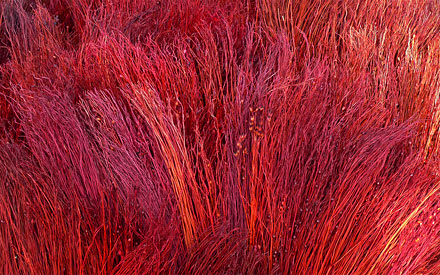
standard resolution / high resolution
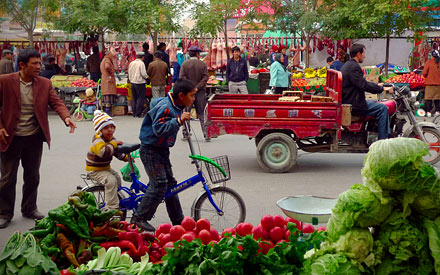
standard resolution / high resolution

standard resolution / high resolution
••••
In other news, I am most definitely the biggest pimp in Beijing.
No, I don't mean that literally. So why then? I met a very nice girl a few weeks ago, and her birthday just happened to be this past Sunday. I was hoping to get her tickets to Elton John and Tim Rice's Aida, which is traveling here this week.
But I ran into trouble: the only tickets left were in the Y480-1,280 range, and I definitely wasn't forking over that much cash. So, I entered a contest sponsored by City Weekend to win two VIP tix and backstage passes... and won! Sweeeeet.
How could she possibly resist me? Don't answer that.
posted November 19, 2008 at 06:25 AM unofficial Xinjiang time | Comments (95)
November 09, 2008
Financial Shit Rolls Down Global Hill
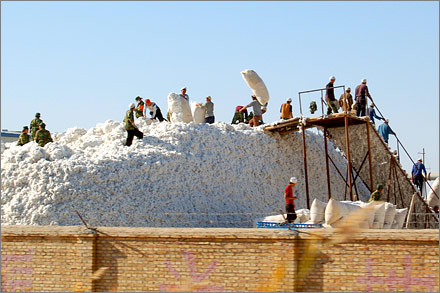
I've just returned from the land of sand and mutton... to read reports that the effects of the global financial crisis have finally made it all the way down to those who can least afford it. There are disturbing reports via Xinhua that as much as half of Xinjiang's recent cotton crop is unsold, and with no apparent buyers in site. From AFP:
Half of the autumn cotton harvest in northwest China's Xinjiang region remains unsold as demand from textile and garment makers has weakened amid the global slowdown, state media said Thursday.
Planters in Xinjiang, China's largest cotton plantation area, are left with more than a million tonnes of unsold cotton, as bulging stockpiles have turned dealers into reluctant buyers, the Xinhua news agency said.
Even an offer from policy lender Agricultural Development Bank of China of 22.4 billion yuan (3.3 billion dollars) in credit to potential buyers has failed to trigger any major interest, it said.
What makes things even worse:
Millions of impoverished farmers find seasonal jobs in the region every year picking cotton, [Xinhua] said.
I'm not even that worried about the local farmers, to tell you the truth. They live off the land, have very few costs, and are able to get by even in very lean times.
I'm thinking more about about the hundreds of thousands of young unemployed guys — mostly Uyghurs — who mill around the cities of southern Xinjiang looking for piecemeal work... the sort of men usually found in outdoor pool halls. Most of them have nothing to do for much of the year, but late summer and fall is their busy season: picking pears, apples, but most of all cotton.
And what about the hundred of thousands of impoverished people from Sichuan who have been imported each year in recent years to pick cotton? They're out of a major source of income as well.
So... a mother in North Carolina decides to hold-off purchasing some new jeans or t-shirts at Wal-Mart for her kids; stockpiles build up at warehouses, and Wal-Mart reduces orders; clothing factories shut down in the Pearl River Delta; cotton cloth manufactures pull the plug in Xi'an; and, farmers and itinerant workers go hungry in Xinjiang.
What's next? I'm not making any predictions, especially outside of Xinjiang. But as for Uyghurs, when you mix increased economic desperation with a sense of increased repression in recent months, pressure is being added to an already dangerous situation. Let's hope it doesn't explode.
On the upside, there will probably be less forced cotton picking in the future for Xinjiang kids.
posted November 09, 2008 at 05:55 AM unofficial Xinjiang time | Comments (181)
November 05, 2008
Obama!
 Well, it's official: Barack Obama is the next President of the United States, and things are suddenly looking a lot better for Americans, especially those of us living overseas.
Well, it's official: Barack Obama is the next President of the United States, and things are suddenly looking a lot better for Americans, especially those of us living overseas.
Why? I think it's safe to say that we've been exposed more frequently to the dislike/hatred of the United States that's grown over the last eight years during the disastrous Bush administration. I'm looking forward to at least four years of some pro-USA love!
Case in point, I just received a short congratulatory message from a Chinese colleague at my place of employment in Beijing:
Congratulations on Obama's successful run for president!! I have been constantly amazed as I follow the elections along the way. What an achievement it truly is... no doubt he'll help restore America's image around the world.
At the same time I can't stop comparing. I can't envision a ethnic Tibetan, Uygur, Hui, or Mogol [sic] gets elected President of China, not in 60 years... that's how far apart the two countries are, in terms of maturity in political institutions.
Anyway, wherever you guys are, I hope you have a great day!
I'm not sure where that "60 years" figure came from, but it's not important today. Good times are here!
posted November 05, 2008 at 10:33 AM unofficial Xinjiang time | Comments (97)
November 03, 2008
Taklamakan Dune Buggy
WARNING May cause motion sickness.
I'm back in Korla for the week. I went out into the Taklamakan Desert yesterday at Luoburen Cunzhai (罗不人村寨)... a place I've visited once every year that I've been in China so far. (You can look at some picture from 2005 here.)
I'd previously taken a ride on the ultralight aircraft available at the site, but I'd never ridden the dune buggies. To tell you the truth, I was worried that the experience was going to be a bit weak. I mean, how much fun can driving around on sand be?
So I told the driver that I wanted to push the extremeness of the ride all the way to 11 in order to make it fun, and scare the friend I was riding with.
Holy s%#*! The portion that I recorded on video above was a bit tamer than the first half of the ride, when even a manly man like me was pretty sure we were about to flip over and die. It was totally worth Y100 per person.
posted November 03, 2008 at 08:18 AM unofficial Xinjiang time | Comments (95)
